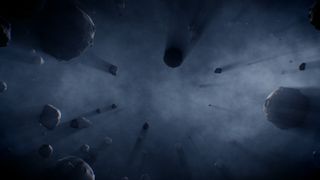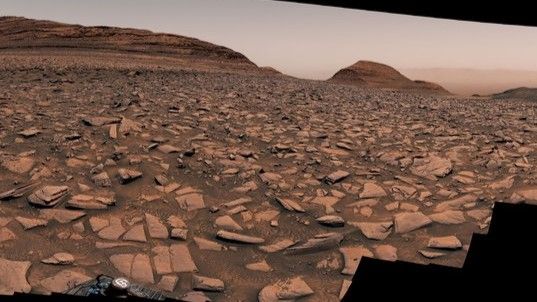Astronomers say they have figured out the true chemical makeup of our solar system, revealing that it contained much more carbon, oxygen and nitrogen than previously thought.
Chiefly, the finding could help explain why Pluto, the largest known object in the Kuiper Belt — a vast region of icy bodies in the outer solar system — is dominated by rock rather than ice. Despite its location in the frigid reaches of the solar system, Pluto's unexpectedly high density has puzzled scientists for decades.
Current models of the primitive gas and dust that formed the solar system "cannot produce the dense, rock-rich features of Kuiper Belt Objects like Pluto," Ngoc Truong, a postdoctoral researcher at the Southwest Research Institute (SwRI) in Texas, told Space.com. "The majority of KBOs are rock-rich instead of ice-rich."
A new study led by Truong, however, is the one that suggests the chemical inventory of the early solar system contained much more carbon, oxygen and nitrogen than once assumed; in particular, a higher abundance of solar carbon would have reduced the availability of water, helping explain why Pluto and other large Kuiper Belt Objects are surprisingly rich in rock, the researchers say.
Related: 2nd Kuiper Belt? Our solar system may be much larger than thought
"With this research, we think we finally understand the mix of chemical elements that made the solar system," study co-author Christopher Glein, an expert in planetary geochemistry at SwRI, said in a recent news release.
The finding, published last week in The Astrophysical Journal, will help scientists more accurately understand stars and planets beyond our solar system formed and evolved across billions of years. "Even further, they enable a broader perspective of galactic chemical evolution," said Truong.
Researchers say the revised chemical estimates are consistent with recent solar data and could help reconcile the longstanding mismatch between two independent methods for determining the sun's composition: spectroscopy, which primarily probes the outermost layer of the sun’s atmosphere, and helioseismology, which studies sound waves traveling through the sun’s interior.
The researchers came up with the new chemical abundance estimates by taking measurements of organics in the comet 67P/Churyumov-Gerasimenko, which likely birthed in the Kuiper Belt and now makes regular visits to the inner solar system. Data sent home by the European Space Agency's Rosetta spacecraft from its rendezvous with the comet suggests chemically resilient compounds called "refractory organics" carried a significant portion of primordial carbon to the outer regions of our solar system, where the Kuiper Belt Objects formed.
The carbon would have been locked within relatively stable compounds like carbon monoxide (CO) and carbon dioxide (CO₂), reducing the amount of free oxygen available to form water ice, Truong said. This, in turn, would help explain why Pluto and other large Kuiper Belt Objects are rock-rich, said Truong.
Computer models incorporating the new estimated abundances successfully reproduced the compositions of Pluto and its largest moon Charon, as well as those of asteroids Ryugu and Bennu, according to the new study. Moreover, the asteroid samples, which were recently delivered to Earth by JAXA's Hayabusa-2 and NASA's OSIRIS-REx missions, lack sulfates. This implies the asteroids accreted less water ice than previously thought, Truong said.
While the findings hold true for the KBO region, researchers say the increased carbon in the ancient solar nebula suggests ice giants like Uranus and Neptune could be hosting more rock than is estimated currently.
"We have been calling Uranus an ice giant, but we don't really know its nature," Truong said. "There are lots of mysteries in our backyard."
.png)
 German (DE)
German (DE)  English (US)
English (US)  Spanish (ES)
Spanish (ES)  French (FR)
French (FR)  Hindi (IN)
Hindi (IN)  Italian (IT)
Italian (IT)  Russian (RU)
Russian (RU) 









Comments